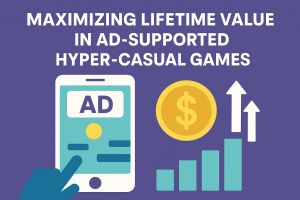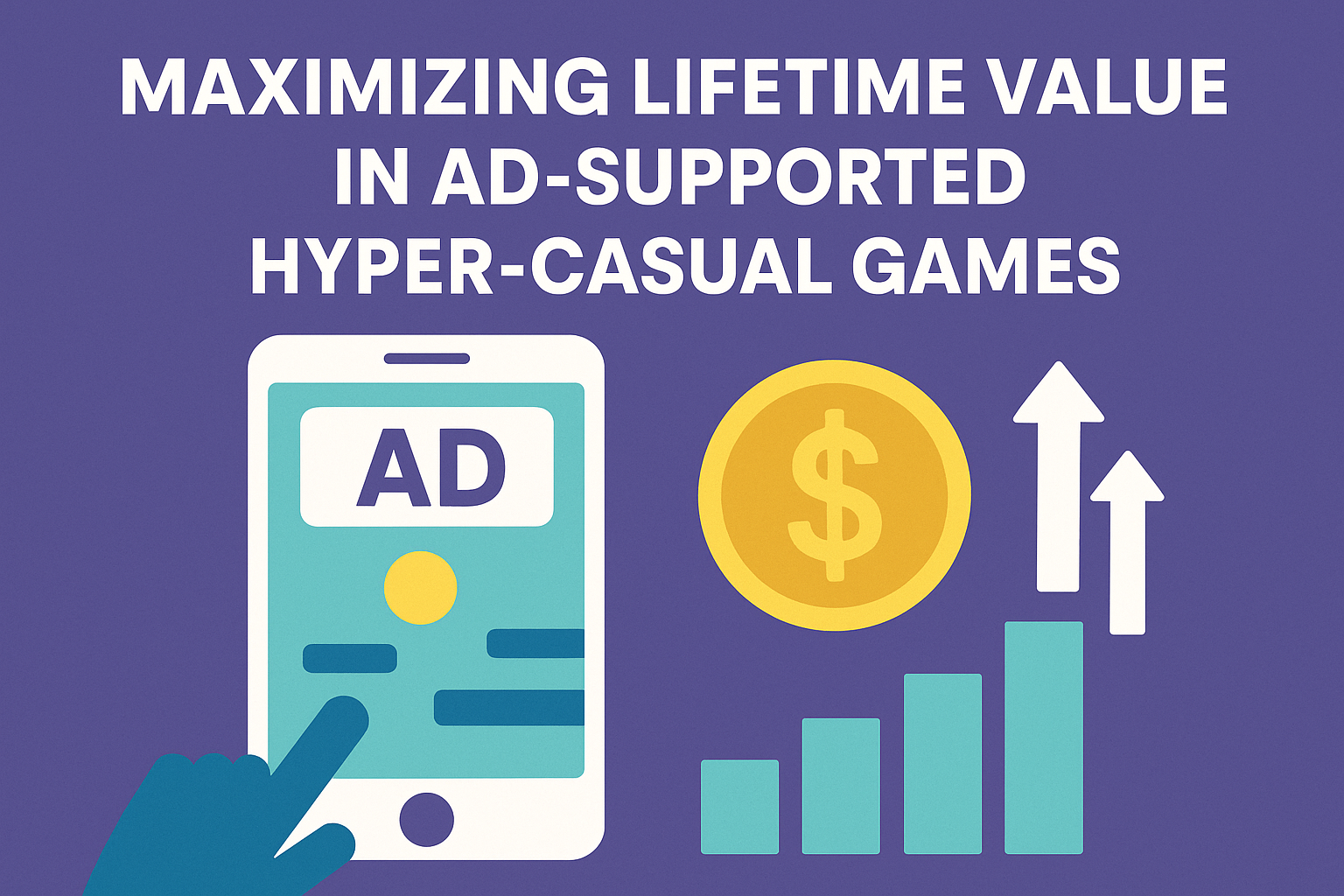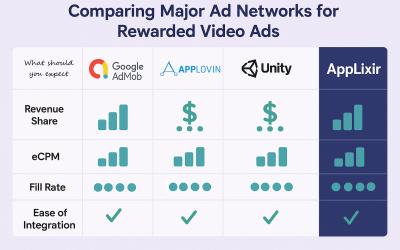Maximizing Lifetime Value in Ad-Supported Hyper-Casual Games
Hyper-casual games are ultra-accessible, simple games that rely primarily on advertising for revenue rather than in-app purchases (IAPs). With average lifetime value (LTV) in the US ranging from $0.60-$1.50 per user, maximizing this metric is crucial for profitability. Higher LTV directly increases revenue and enables more spending on user acquisition while maintaining profitability.
The challenge: these games typically have short player engagement periods—often just days or weeks. To boost LTV without IAPs, developers must optimize advertising opportunities without driving players away.
Contents
- 1 Current Trends in Hyper-Casual Ad Monetization
- 2 Key Advertising Formats and Their Effectiveness
- 3 Best Practices for Ad Placement and Frequency
- 3.1 Use Natural Gameplay Breaks for Ads
- 3.2 Front-Load Player Experience, Not Ads
- 3.3 A/B Test Ad Frequency Rigorously
- 3.4 Match Ad Types to Player Context
- 3.5 Don’t Stack Ads Back-to-Back
- 3.6 Offer a “No Ads” Purchase (Optional)
- 3.7 Leverage Mediation and Competitive Ad Serving
- 3.8 Maintain Ad Content Quality
- 4 AppLixir Rewarded Video Ads
Current Trends in Hyper-Casual Ad Monetization
High Volume, Low LTV
Hyper-casual publishers pursue scale to compensate for low per-user revenue. Studios rapidly produce many titles, knowing only a few will become hits. A game making ~$0.50 per user can be highly profitable with tens of millions of players.
Heavy Reliance on Rewarded and Interstitial Ads
Rewarded video ads have become the cornerstone of hyper-casual monetization, offering a win-win scenario where users receive bonuses while developers get paid. Interstitial ads (full-screen ads between gameplay) capitalize on the natural breakpoints in hyper-casual games’ quick sessions.
Continued Presence of Banner Ads
Despite being considered less fashionable, banner ads provide incremental revenue with minimal user disruption. Recent studies suggest they can outperform poorly implemented video ads and native ads in post-install engagement.
Focus on Ad Experience and Retention
Developers now recognize that excessive or intrusive ads hurt retention and LTV. Teams conduct rigorous A/B testing to find the optimal balance between ad revenue and user retention. Some implement timers (e.g., minimum 30 seconds of gameplay between interstitials) or adjust ad frequency based on user segments.
Hybridization and Deeper Engagement
While pure hyper-casual games rely solely on ads, there’s a trend toward hybrid-casual models with slightly deeper gameplay or light IAPs. Adding meta-progression (unlockable skins or levels) can extend retention, resulting in more ad views per user and higher LTV.
Cross-Promotion Ecosystems
Large publishers leverage cross-promotion as part of their ad strategy, advertising their own games inside others. This helps sustain overall retention across a portfolio and can provide mutual benefits when done as swaps with partner studios.
Key Advertising Formats and Their Effectiveness
Rewarded Video Ads
In these opt-in ads, players voluntarily watch videos (15-30 seconds) for in-game rewards like extra coins, lives, or power-ups. Benefits include:
- Aligned with user interests, enhancing satisfaction rather than causing annoyance
- High eCPMs as advertisers pay premiums for assured views
- Improved engagement metrics as rewards encourage longer play sessions
- Potential to increase retention when players stick around to use their rewards
An OpenX study found 77% of users are willing to watch a 30-second ad for an in-game reward—underscoring this format’s acceptability when value is offered.
Interstitial Ads
These full-screen ads appear at natural pauses or transitions. They may be static images, videos, or playable demos of other games. Interstitials work well in hyper-casual games due to the frequent natural breaks between quick rounds or levels.
While they deliver a large share of total ad impressions, interstitials can provoke irritation if overused. Developers must carefully balance frequency with caps (e.g., one every two levels) or implement skippable options to preserve user goodwill.
Banner Ads
These small rectangular ads typically anchor to screen edges and remain visible during gameplay, updating every 30-60 seconds. While individual impressions earn little, their persistence generates substantial impressions over time.
Despite low click-through rates, banners minimally impact user experience. They’re most effective in games where players spend 5-10 minutes or more per session, allowing multiple impression cycles.
Other Formats
- Native ads: Styled to look like part of the app’s content, though relatively rare in hyper-casual games due to their simple UI
- Cross-promotional ads: Advertising a developer’s other titles within their games
- Playable ads: Mini-versions of other games that keep users entertained during ad breaks
Best Practices for Ad Placement and Frequency
Use Natural Gameplay Breaks for Ads
Insert ads at logical moments in the game flow, such as level transitions, game over screens, or loading pauses. Never show interstitials during active gameplay. By aligning ads with natural pauses, players are less annoyed and more likely to continue after the ad.
Front-Load Player Experience, Not Ads
Avoid bombarding new players with ads in their first few minutes. Implement an “ad delay” for the first few levels or seconds of gameplay. Once players are invested in the game, they’ll be more tolerant of advertising.
A/B Test Ad Frequency Rigorously
What works for one game may not work for another. Conduct A/B tests to find the optimal frequency for your specific audience:
- Test showing interstitials after every level versus every other level
- Experiment with different cooldown timers (15s vs. 45s between ads)
- Try different numbers of rewarded opportunities per session
- Monitor session length and drop-off points to identify potential issues
Match Ad Types to Player Context
Place different ad formats where they make the most sense:
- Rewarded videos: Offer at points where players could use a boost (end of level to multiply coins, after failure to continue)
- Interstitial ads: Show during moments of low user tension (after completing a level)
- Banner ads: Keep in unobtrusive screen areas
Consider the player’s emotional state—showing an ad after a frustration can compound it, while showing one after a victory might be more acceptable.
Don’t Stack Ads Back-to-Back
Spread out ad occurrences to avoid irritating players. Implement rules preventing multiple consecutive ads, like “never show an interstitial within X seconds of a rewarded ad.” Give breathing room between ad experiences to prevent the feeling of bombardment.
Offer a “No Ads” Purchase (Optional)
While focusing on ad monetization, consider offering a small-price Remove Ads IAP ($2.99) as a goodwill gesture. The small percentage of players (1-2%) who hate ads but love the game might pay to disable them, providing additional revenue.
Leverage Mediation and Competitive Ad Serving
Use ad mediation platforms to ensure you get the highest-paying ads and good fill rates. Integrate multiple networks to cover global audiences and enable ad caching to avoid delays between levels.
Maintain Ad Content Quality
Be mindful of ad content, especially for games with younger audiences. Filter out problematic categories (overly sexual or violent ads) even if it slightly lowers eCPM. Regularly experience the ads yourself to ensure they align with your user expectations and don’t damage trust.
AppLixir Rewarded Video Ads
Effective ad monetization in hyper-casual games requires careful balance—showing enough ads to maximize revenue without driving players away. By implementing the right mix of ad formats at appropriate times and continuously testing to find optimal frequencies, developers can significantly boost LTV.
The most successful hyper-casual games treat advertising as an integrated part of the player experience rather than an unwelcome interruption. When executed properly, ads can coexist with engaging gameplay, creating sustainable revenue from non-paying users while maintaining healthy retention metrics.



